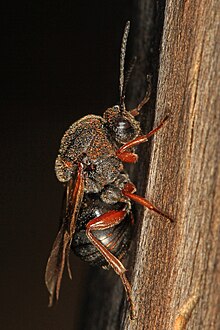Gall wasps
| Gall wasp | |
|---|---|
 |
|
| Scientific classification | |
| Kingdom: | Animalia |
| Clade: | Euarthropoda |
| Class: | Insecta |
| Order: | Hymenoptera |
| Superfamily: | Cynipoidea |
| Family: | Cynipidae |
Gall wasps, also called gallflies, are a family (Cynipidae) of the order Hymenoptera and are classified with the Apocrita suborder of wasps in the superfamily Cynipoidea. Their common name comes from the galls they induce on plants for larval development. About 1300 species of this generally very small creature (1-8 mm) are known worldwide, with about 360 species of 36 different genera in Europe and some 800 species in North America.
Like all Apocrita, gall wasps have a distinctive body shape, the so-called wasp waist. The first abdominal tergum (the propodeum) is conjoined with the thorax, while the second abdominal segment forms a sort of shaft, the petiole. The petiole connects with the gaster, which is the functional abdomen in apocritan wasps, starting with the third abdominal segment proper. Together, the petiole and the gaster form the metasoma, while the thorax and the propodeum make up the mesosoma.
The antennae are straight and consist of two or three segments. In many varieties, the backside of the mesosoma appears longitudinally banded. The wings are typically simply structured. The female's egg-depositing ovipositor is often seen protruding from the tip of the metasoma.
The reproduction of the gall wasp is partly pure two-sex propagation, and partly pure parthenogenesis, in which a male is completely unnecessary. With most species, however, an alternation of generations occurs, with one two-sex generation and one parthenogenic generation annually. This process differentiates the various generations primarily in their appearance and the form of the plant galls they induce.
...
Wikipedia
